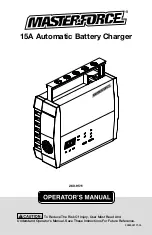
Page 7
6.3
Check polarity of battery posts. POS-
ITIVE (POS, P, +) battery post usually
has larger diameter than NEGATIVE
(NEG, N, –) post.
6.4
Determine which post of battery is
grounded (connected) to the chas-
sis. If negative post is grounded to
chassis (as in most vehicles), see
(6.5). If positive post is grounded to
the chassis, see (6.6).
6.5
For negative-grounded vehicle, con-
nect POSITIVE (RED) clip from battery
charger to POSITIVE (POS, P, +)
ungrounded post of battery. Connect
NEGATIVE (BLACK) clip to vehicle
chassis or engine block away from
battery. Do not connect clip to carbu-
retor, fuel lines, or sheet-metal body
parts. Connect to a heavy gauge metal
part of the frame or engine block.
6.6
For positive-grounded vehicle, con-
nect NEGATIVE (BLACK) clip from
battery charger to NEGATIVE (NEG,
N, –) ungrounded post of battery.
Connect POSITIVE (RED) clip to
vehicle chassis or engine block away
from battery. Do not connect clip to
carburetor, fuel lines, or sheet-metal
body parts. Connect to a heavy
gauge metal part of the frame or
engine block.
6.7
When disconnecting charger, turn
switches to off, disconnect AC cord,
remove clip from vehicle chassis,
and then remove clip from battery
terminal.
6.8
See
Operating Instructions
for length
of charge information.
7. FOLLOW THESE STEPS WHEN BATTERY IS OUTSIDE VEHICLE
A SPARK NEAR THE BATTERY MAY
CAUSE A BATTERY EXPLOSION. TO
REDUCE THE RISK OF A SPARK NEAR
THE BATTERY:
7.1
Check polarity of battery posts. POS-
ITIVE (POS, P, +) battery post usually
has a larger diameter than NEGATIVE
(NEG, N, –) post.
7.2
Attach at least a 24-inch-long 6-gauge
(AWG) insulated battery cable to
NEGATIVE (NEG, N, –) battery post.
7.3
Connect POSITIVE (RED) charger
clip to POSITIVE (POS, P, +) post of
battery.
7.4
Position yourself and free end of
cable as far away from battery as
possible – then connect NEGATIVE
(BLACK) charger clip to free end of
cable.
7.5
Do not face battery when making
final connection.
7.6
When disconnecting charger, always
do so in reverse sequence of con-
necting procedure and break first
connection while as far away from
battery as practical.
7.7
A marine (boat) battery must be
removed and charged on shore. To
charge it on board requires equipment
specially designed for marine use.
8. GROUNDING AND AC POWER CORD CONNECTIONS
8.1
This battery charger is for use on a
nominal 120 volt circuit and has a
grounded plug. The charger must be
grounded, to reduce the risk of electric
shock. The plug must be plugged into
an outlet that is properly installed and
grounded in accordance with all local
codes and ordinances. The plug pins
must fit the receptacle (outlet). Do not
use with an ungrounded system.
8.2
Never alter the AC
cord or plug provided – if it does not
fit the outlet, have a proper grounded
outlet installed by a qualified elec-
trician. An improper connection can
result in a risk of an electric shock or
electrocution.
NOTE: Pursuant to Canadian Regu-
lations, use of an adapter plug is not
allowed in Canada. Use of an adapter
plug in the United States is not rec-
ommended and should not be used.
Содержание 260-9511
Страница 14: ...Page 14 NOTES ...
Страница 15: ...Page 15 NOTES ...
Страница 16: ... 2020 Menard Inc Eau Claire WI 54703 03 2020 ...


































